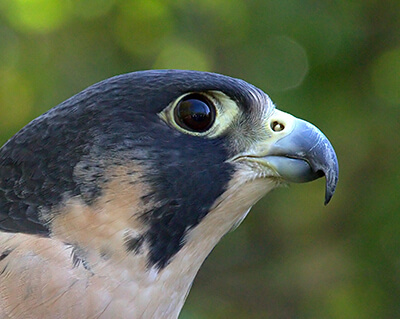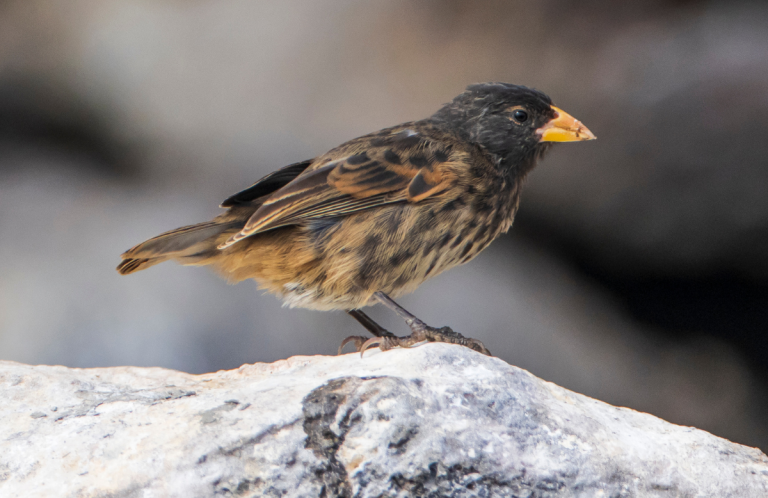 The Peregrine Falcon's species name, peregrinus, comes from the Latin word meaning "to wander," and true to its name, this formidable falcon wanders widely, and is found on every continent except Antarctica. Like the American Kestrel and other falcons, the Peregrine Falcon has long, pointed wings, which give it a distinctive flight silhouette, even in poor lighting conditions.
The Peregrine Falcon's species name, peregrinus, comes from the Latin word meaning "to wander," and true to its name, this formidable falcon wanders widely, and is found on every continent except Antarctica. Like the American Kestrel and other falcons, the Peregrine Falcon has long, pointed wings, which give it a distinctive flight silhouette, even in poor lighting conditions.
Built for Speed
Peregrine Falcons hunt from high in the air above land or water. Their best-known hunting technique is the "stoop," a steep dive from as high as 1,000 feet during which a Peregrine Falcon can reach a speed over 200 miles per hour, faster than any other animal.
The Peregrine is beautifully adapted for high-speed hunting, with long, tapered wings for maneuvering at high speeds and strong feet and talons, used to initially strike, then grasp its prey. The tremendous impact generated by a Peregrine's stoop may kill smaller prey immediately, while larger quarry is knocked to the ground and dispatched there.
Like all falcons, the Peregrine's beak has a tomial tooth, a triangular notch on the upper mandible. This "tooth" allows the falcon to quickly sever its prey's spinal column at the base of the skull, killing it quickly. The nostrils on a falcon's beak contain small, bony tubercles that break up air flow during high-speed dives, allowing the bird to continue breathing easily.

This close-up of a Peregrine Falcon shows the tomial tooth on the upper beak and the bony tubercle in the nostril – both adaptations that help make this bird a swift and formidable predator. Photo by Greg Hume.
Global Citizen
The Peregrine Falcon occurs around the world, and varies widely in size, coloration, and preferred habitat, with 19 different subspecies recognized. Northern populations tend to be migratory, moving along mountain ridges and shorelines, singly or in pairs. Some North American Peregrine Falcons migrate long distances, from Arctic regions to South America. Many southern and island populations do not migrate at all.
Duck Hawk
In North America, one of the Peregrine Falcon's folk names is "duck hawk." As with other birds of prey such as the Red-tailed Hawk or Great Horned Owl, the female Peregrine Falcon is noticeably larger than the male, and females often hunt Blue-winged and Green-winged Teal and other duck species. A male Peregrine is called a "tiercel." This word derives from the old English word "tierce," meaning one-third, and refers to the size disparity between the sexes.
Pigeons and doves are other preferred Peregrine targets, particularly in suburban and urban areas. Like the Cooper's Hawk, the Peregrine Falcon also captures shorebirds and songbirds. It is quick to take advantage of prey that is abundant and available, also catching bats, other small mammals, lizards, and even insects.

Peregrine Falcon by TPC Imagery Mike Jackson, Shutterstock
Aerial Courtship
During nesting season, a male Peregrine establishes a territory, then courts a passing female with acrobatic aerial displays, including dives, loops, and rolls. The male also passes food to the female on the wing, the female rolling over mid-air to accept it from his talons. Once mated, the female Peregrine chooses a nest site on a high, remote cliff or ledge. This simple "scrape" is merely a shallow depression in the rocks and soil, sometimes fringed with twigs and grass. Peregrine Falcons have adapted well to city living, and will nest on tall buildings and bridges in addition to rocky cliffs.
Immature Peregrines have brown backs with heavy, dark streaks below. They acquire adult plumage in their second year, but most do not reproduce until the age of three.
Endangered Species Act Beneficiary
Pesticide poisoning, habitat loss, shooting, and the taking of eggs and young all contributed to the decline of the Peregrine Falcon in much of its historic range in North America.
Along with the Brown Pelican, Osprey, and Bald Eagle, the Peregrine Falcon was almost wiped by the widespread use of DDT as an insecticide, which began in the 1940s. The species was listed under the Endangered Species Act (ESA) in 1970, but concerted conservation efforts resulted in its removal from the endangered species list in 1999. This historic recovery was aided by the release of captive-bred Peregrines.
Read more about the contributions of the ESA to bird conservation and why ABC is so concerned about current threats to the Act. You can help us keep the ESA strong and effective by contacting Congress.
Donate to support ABC's conservation mission!



















































